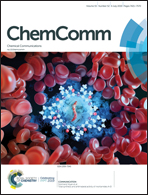Redox active [Pd2L4]4+ cages constructed from rotationally flexible 1,1′-disubstituted ferrocene ligands†
Abstract
Two new ferrocene-containing [Pd2(LFc)4]4+(X−)4 (where X− = BF4− or SbF6−) self-assembled cages (C·BF4 and C·SbF6) were synthesised from the known, rotationally flexible, 1,1′-bis(3-pyridylethynyl)ferrocene ligand (LFc), and characterised by 1H, 13C and diffusion ordered (DOSY) NMR and UV-visible absorption spectroscopies, high resolution electrospray ionisation mass spectrometry (HR-ESI-MS), elemental analysis, X-ray crystallography and cyclic voltammetry (CV). The molecular structures confirmed that cage-like systems (C·BF4 and C·SbF6) were generated. Similar to related [Pd2L4]4+(X−)4, C·SbF6 was able to interact with a range of neutral and anionic guests, with p-toluenesulfonate showing the strongest association constant. Cyclic voltammetry studies revealed that the cage systems were redox active. However, the redox potential of the cage was unperturbed upon the addition of guests.
![Graphical abstract: Redox active [Pd2L4]4+ cages constructed from rotationally flexible 1,1′-disubstituted ferrocene ligands](/en/Image/Get?imageInfo.ImageType=GA&imageInfo.ImageIdentifier.ManuscriptID=C9CC03321A&imageInfo.ImageIdentifier.Year=2019)


 Please wait while we load your content...
Please wait while we load your content...